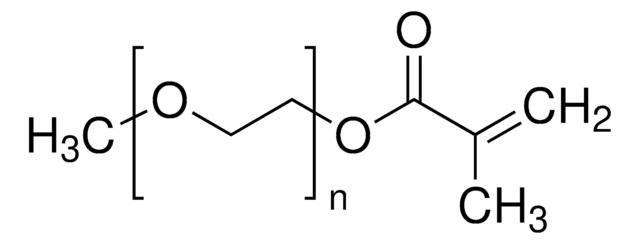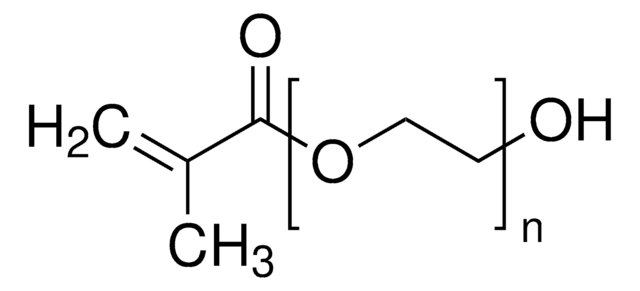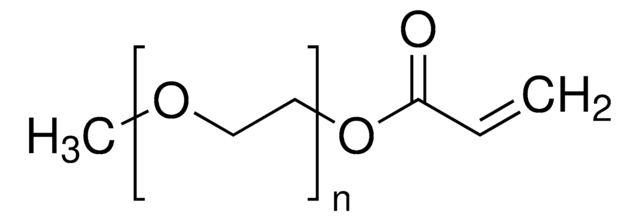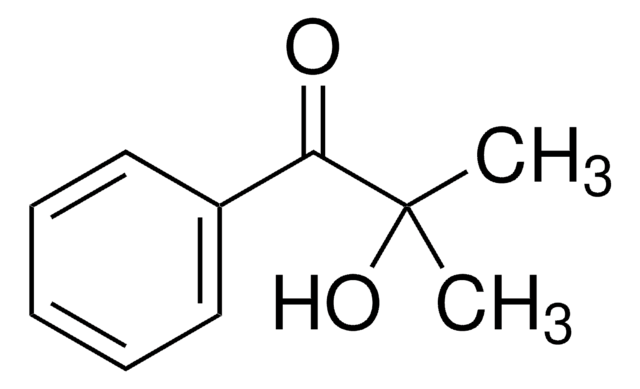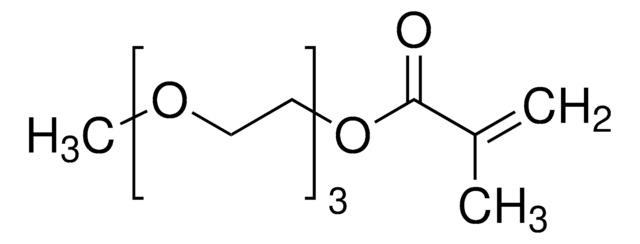Kluczowe dokumenty
409537
Poly(ethylene glycol) methacrylate
average Mn 360, methacrylate, 500-800 ppm MEHQ as inhibitor
Synonim(y):
Ethoxylated 2-hydroxyethyl methacrylate, PEGMA, Poly(ethylene oxide) monomethacrylate, Polyethylene glycol
About This Item
Polecane produkty
Nazwa produktu
Poly(ethylene glycol) methacrylate, average Mn 360, contains 500-800 ppm MEHQ as inhibitor
Formularz
liquid
Poziom jakości
masa cząsteczkowa
average Mn 360
zawiera
500-800 ppm MEHQ as inhibitor
przydatność reakcji
reagent type: cross-linking reagent
reaction type: Polymerization Reactions
współczynnik refrakcji
n20/D 1.464
gęstość
1.105 g/mL at 25 °C
Ω-koniec
hydroxyl
α-koniec
methacrylate
architektura polimerowa
shape: linear
functionality: heterobifunctional
ciąg SMILES
O(CCO)C(=O)C(=C)C
InChI
1S/C6H10O3/c1-5(2)6(8)9-4-3-7/h7H,1,3-4H2,2H3
Klucz InChI
WOBHKFSMXKNTIM-UHFFFAOYSA-N
Szukasz podobnych produktów? Odwiedź Przewodnik dotyczący porównywania produktów
Opis ogólny
Zastosowanie
- Degradable microspheres using asuspension polymerization process. The amphiphilic nature of PEGMA allows performingthe polymerization by direct oil in the water suspension process.
- Polymeric chelating beads for the effectiveremoval of heavy metals from aqueous solutions.
Postać fizyczna
Hasło ostrzegawcze
Warning
Zwroty wskazujące rodzaj zagrożenia
Zwroty wskazujące środki ostrożności
Klasyfikacja zagrożeń
Skin Irrit. 2
Kod klasy składowania
10 - Combustible liquids
Klasa zagrożenia wodnego (WGK)
WGK 3
Temperatura zapłonu (°F)
235.4 °F - closed cup
Temperatura zapłonu (°C)
113 °C - closed cup
Środki ochrony indywidualnej
Eyeshields, Gloves, type ABEK (EN14387) respirator filter
Wybierz jedną z najnowszych wersji:
Masz już ten produkt?
Dokumenty związane z niedawno zakupionymi produktami zostały zamieszczone w Bibliotece dokumentów.
Klienci oglądali również te produkty
Produkty
Progress in biotechnology fields such as tissue engineering and drug delivery is accompanied by an increasing demand for diverse functional biomaterials. One class of biomaterials that has been the subject of intense research interest is hydrogels, because they closely mimic the natural environment of cells, both chemically and physically and therefore can be used as support to grow cells. This article specifically discusses poly(ethylene glycol) (PEG) hydrogels, which are good for biological applications because they do not generally elicit an immune response. PEGs offer a readily available, easy to modify polymer for widespread use in hydrogel fabrication, including 2D and 3D scaffold for tissue culture. The degradable linkages also enable a variety of applications for release of therapeutic agents.
Devising biomaterial scaffolds that are capable of recapitulating critical aspects of the complex extracellular nature of living tissues in a threedimensional (3D) fashion is a challenging requirement in the field of tissue engineering and regenerative medicine.
Nasz zespół naukowców ma doświadczenie we wszystkich obszarach badań, w tym w naukach przyrodniczych, materiałoznawstwie, syntezie chemicznej, chromatografii, analityce i wielu innych dziedzinach.
Skontaktuj się z zespołem ds. pomocy technicznej